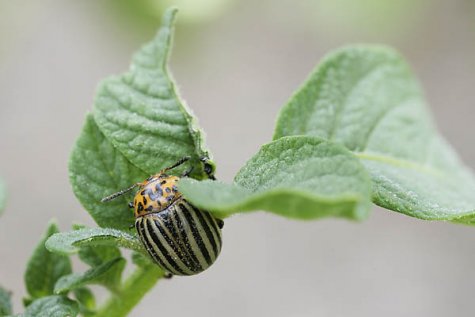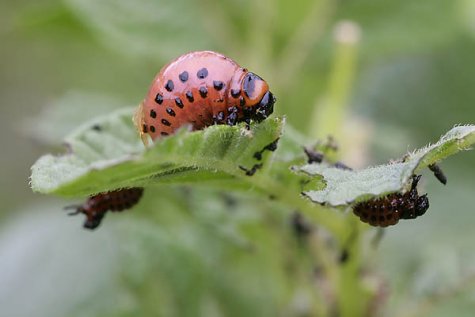Drought set Colorado beetles moving?
Text: Urmas Tartes
Photos: Arne Ader
Translation: Liis
| Colorado beetle; Colorado potato beetl |
Kartulimardikas; koloraado mardikas
|
The beetle is up to 10 mm long, bright yellow-orange coloured, with brown streaks. The most effective control method is to pick the beetles and their larvae by hand, and to crush their orange eggs on the plant leaves; for spraying environmentally friendly basil infusion can be used.
On October 12, 1492, Christopher Columbus surprised the inhabitants of the Bahamas islands with the announcement that they now were subjects of the Spanish king. Obviously the ancient inhabitants could not leave such insolence from the occupants unpunished. .
It took a little less than four hundred years for the invaders sent out from America to reach the European coast for the first time. After the Second World War the invaders had conquered the whole of Europe. And this invasion took place without a single gunshot. Helpers were the Europeans themselves.
Smart strategy
To start with, about half a century after the conquests of Columbus, Europeans were made dependent on the potatoes used by the Inca Indians of Peru and Bolivia. In the beginning progress was slow. The first notices of potatoes being grown for food are from the end of the 16th century from Spain.
The spread of potatoes to all Europe still took some hundred years longer: there were prejudices against the plant with the poisonous above-ground parts. But then the results were so good that potatoes became the staple food of the whole population. The potato produces a much more stable yield than for instance wheat and it isn’t harmed by a wet summer. In Ireland potatoes for instance constituted up to 80% of the food in the beginning of the 19th century.
Supported by the cultivation of potatoes the population of Europe increased and the industrial revolution took place. Potatoes were brought to North America by immigrants from Europe. So the preparations for the stripe-coated conqueror were made.
Striped conqueror
In 1824 entomologist Thomas Say described a yellow, black-striped beetle species that had been collected from a native nightshade (Solanum). When the beetle was found in great numbers on a wild nightshade in the state of Colorado the name Colorado beetle began to be used. It is however believed that the original home of the Colorado beetle is Mexico, but in Mexico there were no entomologists doing investigations at that time.
Nobody at any rate suspected any link between the beetle and the potato plant grown for food, because all finds up to then were from wild plant species. But when the Europeans colonizing America had cultivated the potato widely the road was open for the Colorado beetle to the ports of the east coast and from there on to the steamships to Europe.
The Colorado beetle was first discovered in a potato field in 1859, in the state of Nebraska. In 1874 the beetle had reached the American east coast. In 1877 the beetle was found for the first time in Europe. The first permanent population was found in France in 1922.
After the Second World War the beetle spread quickly through the whole of Europe; by today it has reached Asia.
In Estonia the Colorado beetle was found for the first time in 1965. The hope was then that the solitary migrant beetles would perish in the winter cold. At first it was so, but now the Colorado beetle is a permanent inhabitant in Estonia. Of course this has been aided by the milder winters and hot summers.
Thorough gluttons
Colorado beetles spend the winter as imagos in soil under the snow cover. In spring the beetles lay their orange egg colonies on potato leaves.
One beetle can produce up to 800 eggs. The larvae as well as the imagos of the Colorado beetle voraciously feed on the leaves and stalks of potato plants. Where the beetles are numerous they can ruin a whole potato crop. Besides potatoes sometimes also tomato plants are eaten.
Today the beetles have become resistant to all common pesticides. The revenge of American nature on Europeans has been severe and effective. The harvest of the most important food plant is at risk every year.
In its native country Mexico the Colorado beetle doesn’t eat potatoes but as before feeds on its ancient food source, wild nightshade species.
„Around Jõgeva the Colorado beetles are there and even the first larvae have been found “, Vello Keppart tells us.










